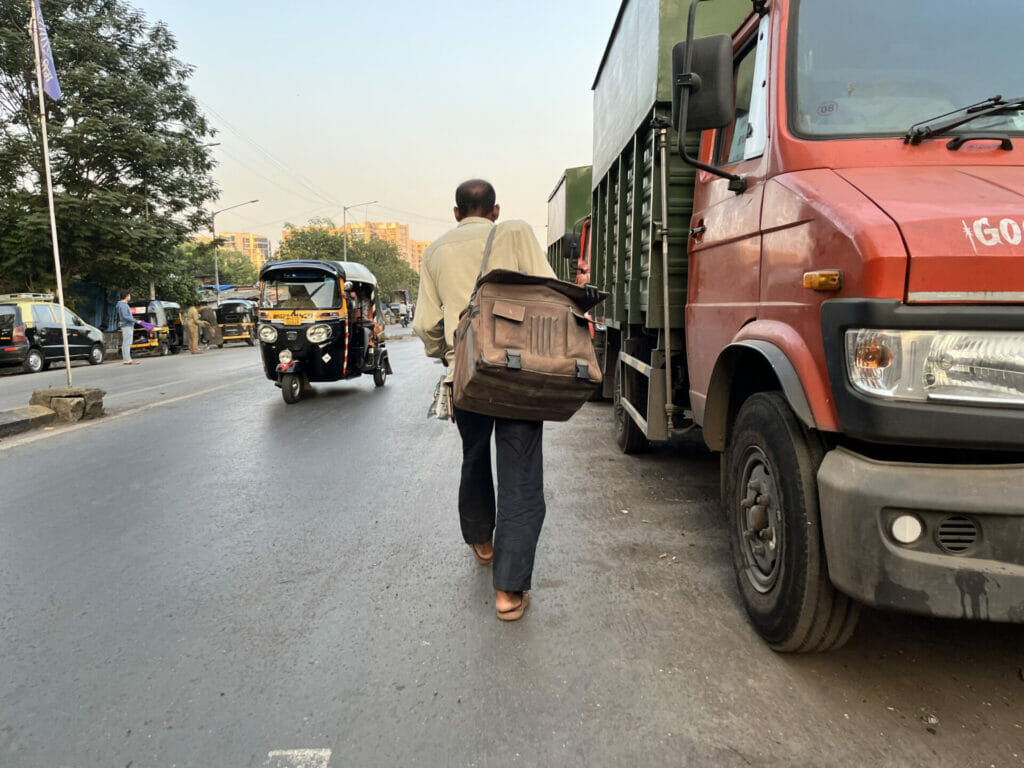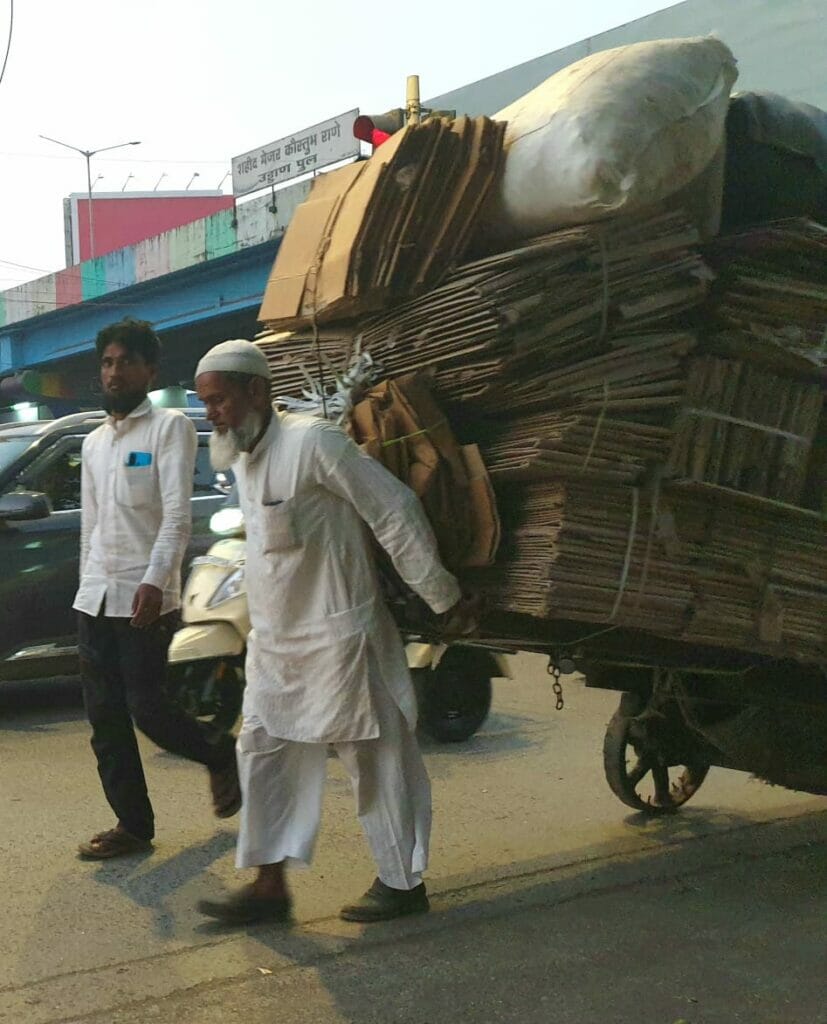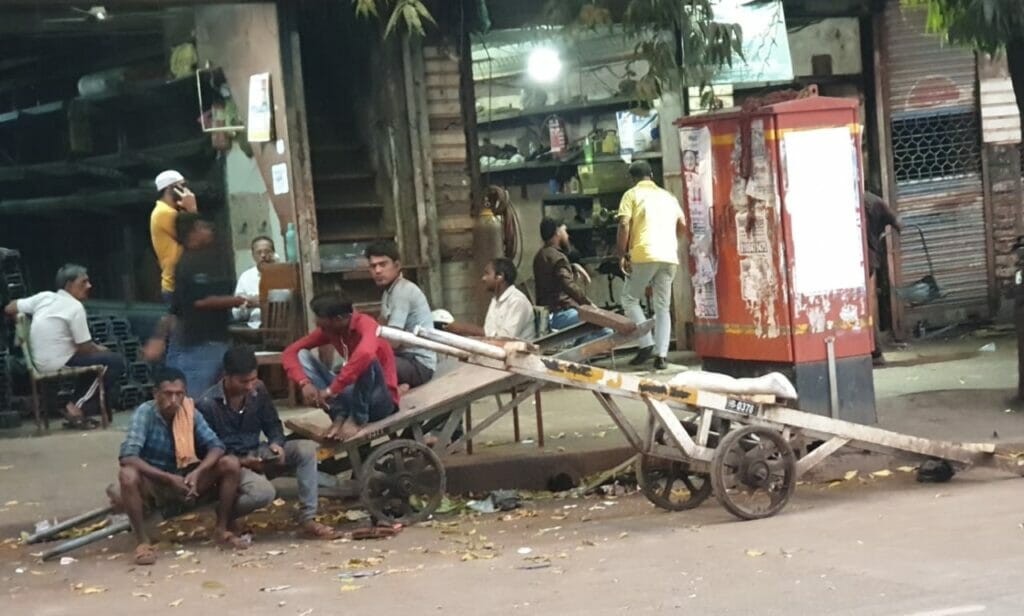Panchasheela Nikalje, 43, almost walked into a ditch full of water one wet July morning in 2022. “I don’t know if we have more rain or worse roads, or both,” she said over the phone. It had been a long day of work swabbing floors of vitrified tile in apartments in suburban Mumbai’s Malad. “But walking to go to work seems riskier every time it rains.”
A resident of Ambujwadi, a sprawling colony of informal homes adjoining a coastal swamp in north-west Mumbai, Panchasheela says she goes to work regardless of the weather. “Bahut baarish ya bahut dhoop me bhi. (On very rainy or very hot days too.)”
The availability of employment as domestic workers never returned to pre-pandemic levels in Mumbai on account of hybrid work patterns among apartment owners. This means that livelihood has remained precarious for Panchasheela, who usually has to walk a distance of 3 km to the bus stop every morning. “We cannot risk taking a day off work due to flooded roads,” she says. “We could lose the job.”

According to Census 2011 data, as many as a quarter of all Mumbaikars walked to work. The Mumbai Metropolitan Region Development Authority’s (MMRDA’s) Comprehensive Transportation Survey in 2008 found that 52% of Mumbaikars made daily walking trips (for work and otherwise). In 2016, the municipal corporations’ report for a comprehensive mobility plan cited a home interview survey of 6,000 residents to say 46% of Mumbaikars walked every day, for various purposes. This did not include multi-modal trips where people may walk or take a bus to a suburban railway station.

Mumbai is packed with people walking to places. Informal labourers and itinerant vendors are walking to work. Office-goers, coping with absent last-mile connectivity, are forced to walk the last couple of kilometres to the office from the nearest railway station. And there are domestic workers, autorickshaw drivers, construction workers, and others doing short walking trips.
For them, the climate crisis is clear and present.
Climate change impact on health
Mumbai has been described in primary school textbooks as enjoying ‘temperate’ weather on account of its proximity to the sea. During India’s hottest-ever March earlier this year, however, Mumbai breached the 40 degrees Celsius mark twice.
Hospitals reported a rise in patients with heat-related conditions, including at least one worker who was critical after suffering a heat-stroke. Those who walk, the most carbon-neutral form of intra-city commute, were clearly at the greatest risk from extreme weather events, rising heat, and poor air quality levels.

Filmmaker, writer, and poet Barnali Ray Shukla, who lives in the Yamuna Nagar area of Andheri (West), calls herself privileged to be able to walk to work meetings for 20 years. She used to also walk to PVR in Juhu, a distance of about 5 km, to watch a film. In recent years though, Barnali has tried to schedule meetings in the early hours or after 4 pm, to beat the heat.
“The sun has been so harsh,” she says, “and despite much protection, I have sun spots and hyperpigmentation. No medicines have helped.” In 2021, a delayed departure of the southwest monsoon meant Mumbai received showers even in November, she says. “When it’s not raining, it’s the construction dust that discourages citizens from walking to work.”
As days get hotter and monsoons more unpredictable, and as the tree cover in her suburb thinned, she has found it hard to convince anyone else to opt to walk. Barnali herself still walks, but less. “Citizens need to know that climate change has not only knocked on the door,” she says, “but is inside our systems.”
Read more: Impact of climate change in Mumbai to increase, according to new report
Not all can choose to walk less
In the Dharavi slum colony, Arumugam D runs a cart selling snacks. It is the itinerant idli vendors who have suffered the worst on account of the rising heat, he says. Known by the ‘pom-pom’ of their horn, these vendors collect tens of thousands of idlis and vadais every morning from units in Dharavi, then board trains or buses to walk around searching for customers in Ghatkopar, Matunga, Dadar, Sion, Kurla, Byculla and elsewhere.
“They can’t stay home complaining about the sun,” Arumugam reasons.
In the case of hawkers and domestic workers, there is no assessment of how rising temperatures or more frequent extreme weather events affect their livelihood or health.

Babli Rawat, president of the All India Trade Union Congress-affiliated Gharkamgar Molkarin Sanghatana, a union of domestic workers in Mumbai, said their members mostly belong to the very hot and arid Marathwada region of central Maharashtra and tend to not complain about the heat. “We should probably ask them specifically,” she says. “We do hear casual comments saying it was very hot while they waited for a bus on a particular day.”
According to Rawat, for women domestic workers in post-pandemic Mumbai, the focus has been largely on keeping their increasingly dwindling jobs.
“But in the monsoon, yes, on days of heavy rain, their homes in slum colonies get flooded and they’re forced more often now than ever to shift into municipal schools or other shelters.” During these times, unable to go to work because the streets or their homes are flooded, there is often loss of pay or termination of services, Rawat says.
The International Labour Organisation (ILO) estimates that by 2030, the world could lose 2.2% of its total working hours on account of high heat levels, the equivalent of 80 million full-time jobs worldwide. India is projected to lose 5.8% of total working hours by 2030 due to heat stress, the equivalent of 34 million full-time jobs.
Impact of heat on pedestrians’ health
Community health specialist Dr. Gulrez S Azhar, a member of the team that in 2013 drew up the Ahmedabad Heat Action Plan, south Asia’s first such effort for city-wide protective measures, said their surveys found that many people should not have been working outdoors in those temperatures. These studies recorded the Wet Bulb Globe Temperature (a measure of heat stress in direct sunlight taking into account temperature, humidity, wind speed, sun angle, and solar radiation) and referenced these measurements against global standards of permissible heat stress.
“Reported temperatures are often based on readings from observation centers outside city limits,” says Dr. Azhar, a fellow at the University of Washington’s Institute for Health Metrics and Evaluation.
The urban heat island effect may expose people to greater levels of heat in parts of the city, especially in densely built cities such as Mumbai. Heat stroke deaths may be fewer, but prolonged exposure to high outdoor temperatures may exacerbate existing health conditions, he says.
In 2014, Dr. Azhar participated in a study on excess deaths during the 2010 heatwave in Ahmedabad. “Many deaths were unaccounted for, they don’t get into the death certificate registration system.”

Advocacy focuses on infrastructure, not people
Advocacy work seeking more pedestrianisation has focused on pedestrian infrastructure, auditing of pavements, medians, access roads to railway stations, etc. Likewise, those who promote non-motorised means of mobility have found the absence of better infrastructure to be an impediment.
Girish Mallya, a public speaker, writer, and endurance runner for 25 years, cycles or runs to work frequently, and says it has become marginally hotter than it used to be.
“But 15% or 20% hotter doesn’t make a lot of difference when you’re going to perspire a lot anyway.” What stops more Mumbaikars from taking up walking or cycling to work, according to Mallya, is the lack of suitable infrastructure in offices, including shower rooms and changing facilities.
In fact, a set of ‘pedestrian-first’ municipal guidelines for pavement design exists on paper, though it makes no note of how to safeguard pedestrians from extreme weather events.
Read more: Political will, citizen action key for Mumbai’s pedestrians
Why people walk in Mumbai
From an affordability perspective, Mumbai’s poor in fact has some of the world’s most heavily subsidised public transport in the suburban railway and the Brihanmumbai Electric Supply & Transport buses.
According to Pankaj Joshi, architect, urban planner, and trustee of the Urban Centre Trust, the mobility problem for the urban poor is one of last-mile connectivity, where metros do not reach every area, the public bus transport system is crippled and, as against global standards for public transport that prescribe a 500-metre walk to home or work upon exiting a mass transit system, Mumbaikars walk considerable longer distances.
Joshi said there is no data to show that shaded walking paths prompt people to switch to using them. Mumbai’s skywalks, he points out, are an example of people simply not opting to move to a different grade to use a shaded walking path through nearly 70% of all modal trips in Mumbai are on foot.
To empower Mumbaikars of all classes to make the safest choice for themselves, the fares of metro systems must be re-assessed to make them more affordable, according to Joshi.
Coping measures for pedestrians, such as access to plentiful and clean drinking water and readily available toilets, are also more challenging for the city’s poorest people who do not have the luxury of deciding not to walk.
Dr. Azhar says, “Heat deaths are a great measure of inequality because heat kills the most marginalised people, those who contributed the least to causing this kind of climate crisis.”